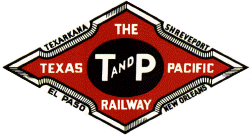 The
Texas & Pacific System
The
Texas & Pacific System
The Texas & Pacific
was a Class 1 railroad criss-crossing the huge expanses of Texas
north -south-east-west. The T&P was part of the Missouri pacific
family in the late 1800's until railroad mogul Jay Gould lost
control of the T&P along with other notable Texas roads such
as M-K-T and I-GN.
The
T&P would once again have ties to the MoPac in 1928 when the
MoP gained control. T&P would retain it's identity for many
years yet until finally being owned outright by MoPac on 10/15/76.
MoPac had owned more that 50% of the T&P at least since 1956.
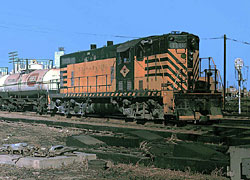 |

T&P 118 - a GP7 in the colorful swamp holly
orange and black paint. Originally delivered in April 1951
as T&P 1118, she will go on to be renumbered as MP 1627
and finally to MP 627. - Photo/The Bill Folsom Collection
(to purchase full-size photos contact Bill at: billfolsom@bellsouth.net
) |
The other Texas Lines in Texas, Gulf Coast Lines and I-GN (International-Great
Northern), were purchased in December 1925. The I-GN was actually
purchased by the NOT&M in 12/1924, but is not considered one of
the Gulf Coast Lines. The other short lines were all consolidated
into the MoPac in 1956.
The Gulf Coast Lines were once owned by the SL-SF (NOT&M, StLB&M
and their subsidiaries). These formed a part of the "Yoakum Empire",
which fell apart in 1913. The GCL operated independently until
the MP takeover in 1925.
A
Historic Overview
1870s
The
Civil War was over, and the goal to construct a southern transcontinental
railroad was revived, thus
the Texas Pacific Railroad Company was established by a federal
charter in 1871, to build a line from Marshall, Texas to San Diego,
California.
On May 2, 1872
by an act of Congress the name was changed to its later form,
the Texas & Pacific Railway Company (T&P).
The T&P was one of only a handful of railroads in the U.S.
to operate under a federal charter, and the only one in Texas,
granted by Congress on March 3, 1871.
The
company was granted a federal land grant of twenty sections of
land per mile through California and forty sections through what
is now Arizona and New Mexico and a state land grant of twenty
sections in Texas. The Texas Legislature recognized the federal
charter in 1871 and authorized the Texas Pacific to purchase the
Southern Trans-Continental Railway Company and the Southern Pacific
Railroad Company, both previously chartered by the state. (This
Southern Pacific was not related to the later Southern Pacific
system that originated out of California). This sixty-six mile
railroad was acquired by the Texas and Pacific on March 21, 1872,
and was the only predecessor of the company in Texas to have built
and operated a railroad. The aquisitions of the Southern Trans-Continental
on March 30, 1872, and the Memphis, El Paso and Pacific Railroad
Company, acquired June 12, 1873, were roads to only reach the
construction phase.
The T&P grew quickly, building a through-line from Texarkana
to Dallas by the end of 1873. The terminus at Texarkana
was of added importance as the St. Louis, Iron Mountain &
Southern Railway had also reached Texarkana earlier that year.
The T&P had a connection back to St. Louis, which greatly
facilitated its growth and profitability. In 1872 the T&P
also extended eastward into Lousiana with the acquisition of the
local SP railroad.
Marshall
O. Roberts was the first president of the T&P, succeeded by
Thomas A. Scott of Philadelphia in early 1872. Grenville M. Dodge
was appointed chief engineer. Construction of the various lines
was commenced by the California and Texas Railway Construction
Company in October 1872, and the 125 miles between Longview and
Dallas was placed in service on July 1, 1873. The seventy-four
miles from Marshall to Texarkana opened for regular service on
December 28, 1873, and the fifty-six miles between Sherman and
Brookston was also built.
Due
to the panic of 1873, construction begun at San Diego was cancelled.
The T&P resumed construction closer to home with the line
from Eagle Ford (Dallas) was extended to Fort Worth on July 19,
1876, and line from Brookston to Texarkana was opened for service
on August 11, 1876, giving the company a total of 444 miles of
line. Over the next several years the railroad attempted, without
success, to finance construction of its line to the Pacific Ocean.
1880s
and Jay Gould's Empire
In the fall of 1879, Jay Gould organized a syndicate to acquire
an interest in and to complete the Texas and Pacific. With General
Dodge again in charge of construction, and solid financial backing,
work resumed in earnest. Track laying began at Fort Worth on April
1, 1880, and the rails reached Sierra Blanca on December 16, 1881.
Dodge had constructed 520 miles of track west of Fort Worth, winding
through land still home to Native Americans, prairie dogs, and
lonely coyotes.
During
1880 the company returned to the construction of its Trans-Continental
Division, forging ninety miles west from Sherman to Fort Worth,
and put into service on May 9, 1881. By the end of 1881 the Texas
and Pacific had 1,034 miles of main track in Texas.
The
California-based Southern Pacific Railroad Company built it's
line to the Colorado River across from Yuma, Arizona Territory,
where it was to meet the Texas and Pacific. However, SP's Collis
P. Huntington choose not to wait for the T&P and continued
to build eastward, reaching El Paso in May 1881, ahead of the
Texas and Pacific.
In its construction the Southern Pacific occupied the line surveyed
and designated by the Texas and Pacific as its right-of-way. This
resulted in suits being filed against the SP by the T&P for
possession of the line between El Paso and Yuma. The dispute was
settled on November 26, 1881, and under the agreement's terms
the T&P was to build no further than Sierra Blanca, ninety-two
miles east of El Paso. The two systems would use the line to El
Paso jointly, forming one continuous line to the coast. The T&P
relinquished its property rights and franchises west of El Paso
to the SP. The agreement also provided for pooling, harmonious
operation, and for the cooperation in the building of new lines.
Later attempts by T&P to contest the agreement terms were
unsuccessful for the most part.
1890s
The Texas and Pacific acquired several lines in Louisiana and
on September 12, 1882, finished a route from Shreveport to New
Orleans. In 1898 the company built from Waskom on the Texas Louisiana
border to Shreveport and relinquished the leased trackage between
the two points that it had used since 1862. Only a singlebranch
was constructed by the T&P in Texas during this period - the
six miles between Mingus and the coal mines at Thurber, built
in 1888. Despite this, the road was active in acquiring or financing
the construction of short lines to feed the system. These included
the Denison and Pacific Suburban Railway Company, acquired in
1895, and the Weatherford, Mineral Wells and Northwestern Railway
Company, acquired in 1903.
 |
T&P 316 - Former Texas &
Pacific Steamer is at the Texas State Railroad in 1993.
Here the locomotive was repainted and renumbered into its
original number for a photographers weekend. Seen at Palestine,
Texas.- Steve Rude Photo/Jay Glenewinkel
Collection
|
1880-1910s
and The Missouri Pacific
Between 1881 and 1885, when the railroad entered receivership,
the Texas and Pacific was leased to the Missouri Pacific Railway
Company. Following the cancellation of the lease, the Texas and
Pacific and the Missouri Pacific continued to work together as
a system through Gould holdings in both companies. With the 1917
reorganization of the Missouri Pacific, Gould interests no longer
controlled the two railroads. The following year the new Missouri
Pacific Railroad Company began to formalize its relationship with
the Texas and Pacific by buying stock in the Texas line.
1920s
In 1927 the Texas and Pacific acquired the Cisco and Northeastern,
the Abilene and Southern, and the Pecos Valley Southern Railway
companies. In 1928 the Texas-New Mexico Railway Company was organized
to build from Monahans to Lovington, New Mexico, and in 1929 the
Texas Short Line Railway Company was purchased. All of these short
line railroads maintained their separate corporate identities.
The
discovery of oil along the Texas and Pacific line in West Texas
during the late 1920s and later in East Texas had a major impact
on the company. In 1928 crude oil accounted for 22 percent of
all freight tonnage.
1930-1940s
The T&P acquired a 60 percent interest in the
Fort Worth Belt Railway Company in 1932. The T&P also owned
a one-eighth interest in the Union Terminal Company at Dallas
and a one-sixth interest in the El Paso Union Passenger Depot
Company. In 1931 the T&P was a force to be reckoned with,
owning 365 locomotives, 236 passenger cars, and 9,816 freight
cars, and earning $24,000,000 in freight revenue, $3,282,000 in
passenger revenue, and $2,721,000 in other revenue.
During
the years of peak crude oil movement the physical condition of
the railroad was significantly improved, and the Texas and Pacific
was able to weather the Great Depression better than many of the
other railroads in its region. Other than the abandonment of the
Cisco and Northeastern on March 9, 1942, and the sale of the Pecos
Valley Southern on November 30, 1946, there was little change
in the Texas and Pacific system for 40 years.
 |
Texas & Pacific # 2500 was the only T&P
caboose to have the high-cupola and triple-window design,
seen here in it's original appearance at Weatherford, Texas
on November 14, 1965. - photo: R. D. Ross, John C. La
Rue, Jr. collection, used with permission. Contact
John for a list
of his r.r. photos.
|
1960s
The Texas Short Line was abandoned on March 7, 1962. In September
1964 the company acquired control of three associated companies
based in Oklahoma, the Kansas, Oklahoma and Gulf Railway Company,
the Midland Valley Railroad Company, and the Oklahoma City-Ada-Atoka
Railway Company. The Oklahoma City-Ada-Atoka was resold to the
Atchison, Topeka and Santa Fe Railway Company, and the Midland
Valley was merged on April 1, 1967, and the Kansas, Oklahoma and
Gulf on April 1, 1970. With the acquisition of trackage rights
over the Missouri-Kansas-Texas Railroad Company between Denison
and Whitesboro, the Denison and Pacific Suburban became surplus
and authority to abandon this line was obtained on April 2, 1965.
In 1968 the Texas and Pacific constructed twenty-nine miles of
track from San Martine to Rockhouse and the next year acquired
nine miles from Fort Worth to Everman from the Missouri Pacific
Railroad Company.

|
TP 2558 - The date is April 10, 1966 at Weatherford,
Texas. The home-built is shown here in its final full Texas
& Pacific scheme. - R. D. Ross Photo/courtesy John
C. La Rue, Jr. Collection, Contact: John
for his list of r.r. photos.
|
1970s
Since the 1930s the Missouri Pacific owned enough Texas and Pacific
stock to give it nearly 75 percent ownership; the Missouri Pacific
continued to increase its interest so that by the end of 1974
it owned nearly 97 percent of the stock. In that year the Texas
and Pacific owned 1,982 miles of main track in Texas, Louisiana,
Oklahoma, and Arkansas. Of the total, 1,109 miles were in Texas.
The railroad also owned a total of 153 diesel units and 3,629
freight cars. Freight revenues in 1974 were $149,073,000. In addition,
the Texas and Pacific continued to control the Abilene and Southern,
Fort Worth Belt, Texas-New Mexico, and Weatherford, Mineral Wells
and Northwestern. On October 15, 1976, the Texas and Pacific was
merged into the Missouri Pacific. (source - Handbook
of Texas Online: TEXAS AND PACIFIC RAILWAY)
 |
Texas & Pacific GP35 #605 -
built in January 1964, #605 is seen in Fort Worth, Texas
in the early 1970s. Note the Texas & Pacific buzzsaw
on the cab. - Mike Bledsoe Slides/Jay Glenewinkel
Collection
|
The
Texas-New Mexico (T-NM)
The
Texas & New Mexico was a subsidiary of T&P. Basically the Texas
and New Mexico was a long branchline extending from Monahans,
Texas (East of Sierra Blanca -- west of Midland-Odessa)
up to Lovington, New Mexico, it came off the route into El Paso.
It
then became known as the T-NM Sub after the line was fully merged
into the MoPac. It was part of the Rio Grande Division and broke
off the Toyah Sub (part of the line between Dallas and El Paso)
at Monahans, TX (MP609.4). It was 105 miles in length heading
north out of Monahans. Monahans is about 249 miles east of El
Paso. UP has since spun this line off to a shortline operator.
(thanks to 'Tuch' Santucci)
The
Texas Eagle
August 15,1948 saw the
first run of the "Texas Eagle", a natural Texan
extension of the popular "Eagle" streamliner service.
The diesel streamliners were popping up everywhere, closing out
the story of steam on other longtime passenger runs as well such
as the "The Texan". The power of the new "Texas
Eagle" were identical in appearance to her older sisters,
which were first seen on the "Missouri Eagle" run, except
for these units wore a Texas diamond on their eagle nose ornamentation
and "Texas & Pacific" emblazoned on their flanks.
 |

T&P 501 - GP18 in white and blue scheme was
delivered in April 1960 as T&P1146. - Photo/The Bill
Folsom Collection (to purchase full-size photos contact Bill
at: billfolsom@bellsouth.net ) |
 The
Texas & Pacific Scheme in the MoPac era
The
Texas & Pacific Scheme in the MoPac era
The
T&P was a proud road and it the emblems of it's identity
did not disappear so quickly as was the case with most other
MoPac predecessors.
The
first T&P locomotives to wear the MoPac buzzsaw were the
GP35's of the 1960's.
A
few GP 7's and 9's continued to wear T&P swamp holly orange
with diamond logo right through the Eagle blue and gray era
until the appearance of Jenk's Blue in 1963.
Over
years of joint operations, in 1962 the T&P and the Missouri
Pacific began merging "officially."
By 1963 T&P F7 units in Jenks Blue could be seen with the
old diamond logo on the nose and the newer buzzsaws on the flanks.
The first T&P units to be delivered in Mopac blue and buzzsaws
were the GP35's (#600-614) in 1964.
There
was not a coordinated move to systematically replace the diamonds
with buzzsaws. Road power and freight equipment alike was repainted
as it came in for servicing throughout the 1960's.
 The
Texas & Pacific Buzzsaw Emblem
The
Texas & Pacific Buzzsaw Emblem
Among
the most recognizable pre-merger symbols but among the rarest
seen - the Texas & Pacific version of the "Buzzsaw"
emblem was used for little more than a year. By the mid 1960's
the T&P Diamond had given away to a buzzsaw with the corporate
name. The emblem was rare on both locomotives and cabooses.
In fact it's unknown just exactly how many of these emblems
were applied to equipment that otherwise was in the usual Missouri
Pacific paint and lettering. T&P sublettering was applied
under these buzzsaws as well. (thanks to Jerry Murray for
supplying list)
|
Known
examples of T&P buzzsaw usage
|
|
Locomotives
|
E7 #2 (passenger loco - had emblem on the nose eagle and
on the sides)
F7A #875, 865
F7A #907 (diamond on front and buzz on side)
E8A #36
E8 #37
(Note: E7's #1, 3 & 4 may have used them on the sides)
GP9 #387 & 388
GP18
#500, 502
GP35
#600-614
SW9
#1223
|
|
Cabooses
|
T&P #2550 (1964) |
|
Passenger
|
Combo
diner-lounge car, originally #525, painted jenks with T&P
buzzsaw renumbered #42 around Christmas 1963, retired and
scrapped in 1969 |
|
Freight
|
No
Reporting Marks - A number of box cars used them |
|
Depots
|
Most
TX depot used T&P buzzsaw on outside of building |
The
"Texas" Class Locomotive
Delivered in 1925 as part of an order for ten Class I-1 locomotives
built by the Lima Locomotive Works, the Texas & Pacific Railroad
received the very first purposely designed 2-10-4 built in North
America. This locomotive, road number 600 along with nine others
(nos. 601 - 609) had 29" dia x 30" stroke cylinders, 63.5 dia.
drivers, a 250 psi boiler pressure, a tractive effort of 83,000
lbs and each weighed 448,000 pounds.
As
was the common custom, the first railroad to receive a new wheel
arrangement was given the honor of naming the new class. T&P
selected the name "Texas" for the 2-10-4s. By 1929 T&P's roster
had expanded to 70 of these "Texas" Class locomotives
The
Texas & Pacific 610 is the sole surviving T&P example
of a "Texas" class. Built in 1927, the engine is owned by the
Texas Railroad and currently displayed in Palestine, Texas. During
the 1976 bicentennial celebration, #610 was restored to operating
condition, in charge of the American Freedom Train on it's route
throughout the southwest .
 |
T&P 610 - the mighty
engine, also owned by the Texas State Railroad, as seen displayed
today in Palestine, Texas - photo © copyright Chris
John |
Diesel builder EMD experimented with a possible Eagle scheme
for the Texas & Pacific F7 in T&P's colors of Swamp Holly
Orange and Black instead of MoPac's Eagle Blue and Gray. This
never got beyond the artwork stage and was never applied to a
single unit. (Jim Ogden)
Check out this example:
http://www.texaspacificrailway.org/php/tpry_images/tpry_images_display.php3?id=646&category=diesel
|
|
Texas
& Pacific and Texas Railroads
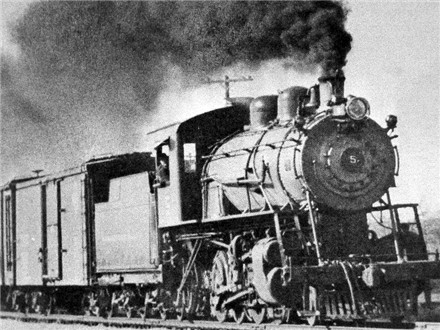
WMW&NW
Steamer in 1923

Texas & Pacific Passenger Train in Ft.
Worth, TX in the 1930s
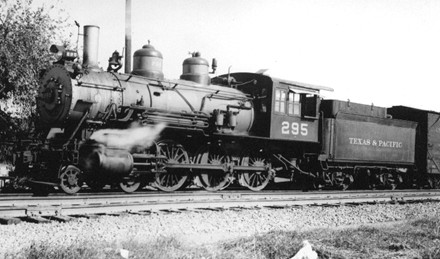
T&P 4-6-0 with a freight in Texas in 1930s
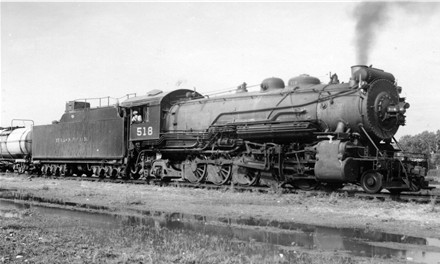
Early Texas Type Loco on the T&P in the
late 1940s
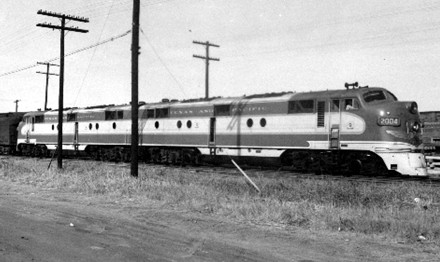
Among
first groups of E-8s on the T&P in the late 1950s
|
|
Recommended
Reading:
A History of Texas Railroads, S. G. Reed, St.
Clair Publishing, 1941
Texas &
Pacific - Color Pictorial, Steve Allen Goen, Four Ways West
Publications, 1997
The Texas & Pacific Railway, Joe G. Collias,
M M Books, 1989
Texas & Pacific Railway: Operations and Traffic,
C. P. Zlatkovich, Westerner
Press, 1998
Texas & Pacific Railway: From Oxcarts to
Eagles, D. Watson &
S. Brown, The Boston Mills Press, 1978
Related
Links:
The
Texas & Pacific Railway - Railfans Depot
http://www.letarc.net/longviewyard/chuck/
- T&P Steam
Don
Ross - Texas State RR
T&P
610 during 1970s Rail Excursion
Photo
of T&P 316 - Jay Glenewinkel
Photo
of T&P 316 - Gary Morris
Photo
of T&P 610 - Chris Johns
Photo
of T&P 610 - Gary Morris
Great
Southwest RR (T&P Subsidiary)